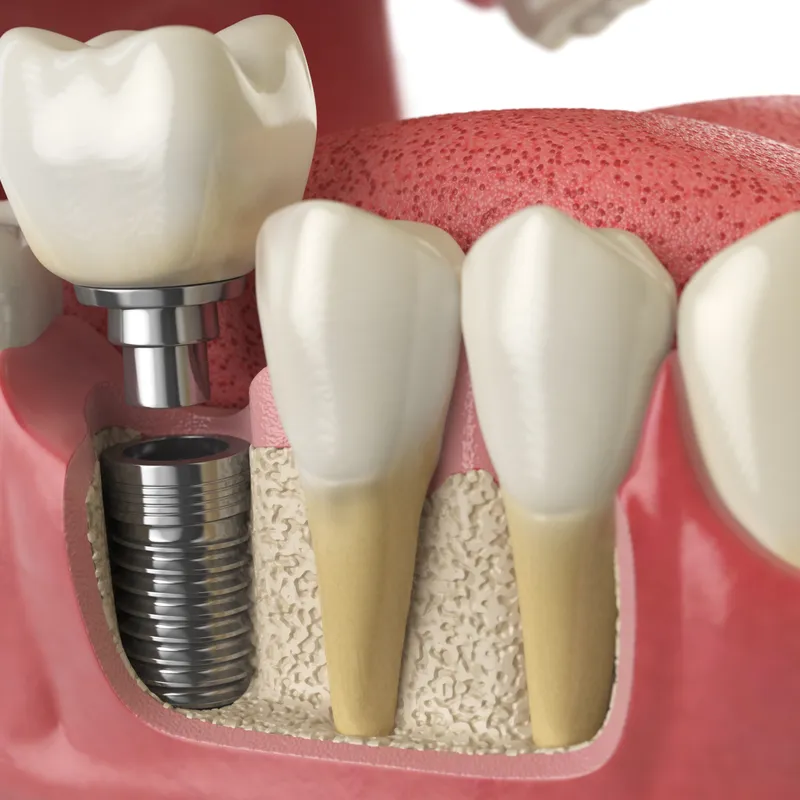
It is the most reliable and long term method of dental prosthetics.
Dental implantation is a procedure in which the root of a missing tooth is replaced with a titanium implant. During the procedure, a small incision is made in the gums, and a cavity is created in the bone where the titanium implant will be inserted. Since the implant acts as the tooth root, it must be placed deeply into the bone. After the implant is secured, the gums are sutured. Because this involves bone intervention, it takes 3 to 6 months for the implant to integrate, after which a dental crown can be placed on it.
When one or more teeth are missing;
Once the jawbone has fully developed;
When there is sufficient bone tissue available or the option for augmentation exists.
When overall oral health is good.
When there are no underlying medical conditions that may affect bone healing.
For patients who prefer not to use removable dentures.
Especially for non-smoking patients.
After the procedure:
Swelling - It's normal for tissues to swell after any surgical intervention.
The peak of swelling typically occurs 2-3 days post-intervention, followed by a gradual reduction.
Bruising - Depending on individual factors, such as one's body composition, bruises may develop in the jaw or gums. They usually resolve within 5-7 days.
Sensitivity at the implant site: Pain and sensitivity may persist for a few days following the procedure. Chewing on the opposite side and taking recommended pain medication can help manage discomfort.
Minimal bleeding: Applying firm pressure with a gauze pad and using a cold ice pack can help reduce bleeding post-procedure.
All other instructions remain similar to those after tooth extraction.
Procedūros trukmė 60–90 min.
Unlike the traditional approach, where a gap is left after tooth removal, this method immediately inserts an implant. It's used when a tooth needs removing but shows no signs of active inflammation, often seen in trauma cases.
This faster process means prosthetic work can start about 3-4 months after the implant is placed.
After the procedure, there might be some swelling and sensitivity at the implant site, managed with medication. It's recommended to chew on the opposite side for comfort.
When placing implants in the upper molar area of the upper jaw, the most common issue encountered is bone resorption (bone loss) in the upper jawbone. Sufficient bone height and thickness are necessary for successful implant placement. However, there is often inadequate bone in the areas of the upper molars and premolars. The primary cause of this deficiency in bone height and thickness is bone atrophy following tooth loss, and sometimes individual anatomy also contributes.
When there is insufficient bone height in this area, a Sinus Floor Elevation Procedure is required. Sinus floor elevation can be performed using either an open or closed approach.
Treatment Process
Open Approach
This method is employed when the bone height at the planned implantation site, near the sinus, is less than 5 millimetres. The procedure is performed under local anesthesia. A small incision is made in the gum tissue, followed by the creation of a small window in the upper jawbone at the projection of the maxillary sinus. The sinus lining is then gently lifted, creating a space between the lining and the bone. This space is filled with artificial bone granules. In some cases, an implant can be placed immediately afterward, while in others, implantation may be performed after 6 months.
Closed Approach
Performed when the bone height near the sinus is between 5-7 millimeters. During this procedure, the implant is always placed. This sinus floor elevation procedure differs minimally from a regular implantation.
During the procedure, specialised instruments are used to lift the sinus floor through the prepared space for the implant, and then the gap created is filled with bone granules. On the other hand, sometimes, this step is unnecessary. In those cases the implant is placed, and the mucosal tissue is sutured as in a standard implantation procedure. After the procedure, the post-operative instructions are the same as after implantation, and patients are advised to avoid flying for a week.
JD implant implantation: €619
JD (Switzerland) SLA Roxolid implant implantation: €759
JD (Switzerland) SLActive Roxolid implant implantation: €849
Single-stage implantation (excluding implant): €150
Bollard implant: €350
Healing cap: €69